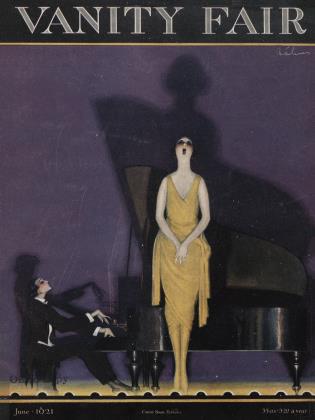Sign In to Your Account
Subscribers have complete access to the archive.
Sign In Not a Subscriber?Join NowAbram Poole's Decorative Portraits
An Impression of Mr. Poole's Recent Exhibit of his Paintings at the Wittgenstein Galleries
CÉCILE SARTORIS
ONE of the characteristics of the exhibition of Decorative Portraits by Abram Poole at the Wildenstein Galleries is a tendency to linger with the spectator, to cling to the imagination, lurk in fantastic corners and recur as some haunting leitmotiv long after the eyes have ceased scrutinizing them.
This is probably because there is such sensitiveness and knowledge of the things beautiful in Mr. Poole's conception of his art. Each of his portraits gives the impression of containing a variety of moods, of evoking periods, some of the past, some of the present, but always with a very refined comprehension of the raison d'être. In dressing his models he transplants them into the domain of his imagination and expresses an epoch, an epoch in perfect keeping with the character he portrays.
Having travelled much and studied keenly various artists and periods in Spain, Italy,
France and England, his expression is influenced according to his moods, and yet there is an originality of mind which leaves a distinct impression of his own personality in each of his canvases.
Albeit his portraits are decorative, the likenesses, both in form and expression, radiate the personality of the sitter to such an extent that you feel as if you had stayed with the person for hours, aware of her moods and interchanging thoughts. Possibly much of this is due to the painting of the hands, each of which is different yet, exquisite, invariably—the modeling, the colour, the listlessness or strength of the hand of the worldly woman who knows it is well shaped and delicately cared for—the pale hands, eager to hold, anticipating life. All these hands, so like and unlike, play upon one's imagination and augment the haunting quality of the face.
The exhibition consisted of seventeen paintings, fifteen portraits, all women, and two decorative panels which resemble brilliant verdure tapestries with their cascades, perspective hills, iridescent foliage and the sprite of the waterfalls fleeing whilst aiming his last arrow into the playing springs.
The portraits are so varied that each one deserves a personal analysis, but among them— aside from the three paintings reproduced on this page—four stand out, those of Sylvia Pankhurst, the Serbian girl with a turban, Miss Voulett Proctor, and the deliciously inane Mannequin.
There are other portraits besides these and as this is the first New York exhibition of a group of paintings by Mr. Abram Poole, the entire collection going on to Chicago, Cincinnati and Boston, it will be most interesting to follow his evolution, to see what the dominant feature in his art will be, whether he will be inspired by the past, the present, or the future, or whether he will continue with perfect ease to paint, one day, à la manière de Goya, on another with his thoughts dwelling on Manet, or will he skip forward still further and emulate Matisse, Picasso, Gleize ?
 View Full Issue
View Full Issue






Subscribers have complete access to the archive.
Sign In Not a Subscriber?Join Now